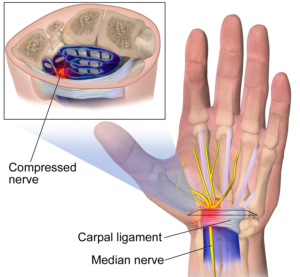
What is Carpal Tunnel Syndrome?
Carpal tunnel syndrome is a condition caused by the compression of the median nerve at the wrist. This nerve provides sensation to the thumb, index, and middle fingers, as well as half the ring finger. The nerve also provides innervation to the muscles of the thumb (thenar muscles). The compression slows/blocks the signal to the hand and with prolonged compression constant numbness occurs and the muscles waste away. It is the most common diagnosis seen by hand surgeons and occurs most often in women.
How to diagnose carpal tunnel?
There is no clear consensus on the best diagnostic test for carpal tunnel syndrome. The diagnosis is often made based on the patient’s history and a physical examination.
Electrodiagnostic studies (EMG/NCV) are tests that help with the diagnosis. It provides a quantitative function of the nerve and muscles. It can also find other causes of numbness that may have similar symptoms, such as diabetic neuropathy or cervical compression. The test is performed by a neurologist using electrodes and stimulation needles. Many patients tolerate the test without difficulty.
Ultrasound is a non-invasive technique to measure the size of the median nerve and has been shown to correlate with carpal tunnel syndrome.
A steroid injection can also be used as a diagnostic test and patients that receive relief from the injection can expect similar results to an operative release. However, carpal tunnel syndrome symptoms often recur months after injection and therefore it is only a temporary measure not curative.
Carpal Tunnel Syndrome Treatments:
Non-Operative treatments
Splints
Bracing is an inexpensive treatment for mild CTS by decreasing pressure on the nerve that occurs with flexion and extension of the wrist. It is often recommended at night to prevent flexion that occurs with sleep.
Exercises
Lumbrical stretches or median nerve glide exercises have been shown to decrease the symptoms in patients with mild CTS when compared to splinting alone. Below are some exercises listed on the AAOS Ortho Info.
Median Nerve Glides
Injections
Steroid injections for the treatment of carpal tunnel syndrome have shown mixed results. While many people have temporary relief from the injection, symptoms often recur within a few months to a year. Younger patients who have symptoms less than 3 months and without constant numbness may have a lasting response. As mentioned above, the relief obtained from a carpal tunnel injection is an excellent prognostic tool for successful carpal tunnel release.
Operative Treatments
When conservative treatments have failed to provide relief operative treatments are recommended. The goal of surgery is to allow more room in the carpal canal, therefore, decreasing the pressure on the median nerve. There are two surgical techniques that Dr. Chambers performs, open (“mini-open”) or endoscopic. Surgery is often performed with Local Anesthesia (Wide-Awake) or with Local+MAC (“twilight”) depending on patients’ preference.
Endoscopic Carpal Tunnel Release
Outcomes After Carpal Tunnel Surgery
The majority of people after carpal tunnel release are satisfied after their release and glad they had it done. Most often nighttime symptoms resolve and some may even have improved the night of surgery. The sensation often improves over time (months) as the median nerve heals. Patients who have constant numbness before surgery may not have a full return of sensation (i.e. permanent) as their nerve has been compressed for a long time. In these patients, the approach is to prevent worsening problems such as muscle loss and the need for tendon transfers.
Better results will occur when carpal tunnel is recognized and treated early. This means seeking treatment when you start developing symptoms and not waiting until they become severe.
What to expect after Carpal Tunnel surgery
It is normal to have some pain after surgery. Often this can be treated with over-the-counter medication only.
See Post Operative Pain Sheet.
When Can I Return to work after surgery?
Everyone has different requirements when it comes to working. Some people are labor intensive (mechanics and construction workers) while others have repetitive tasks (typing). Therefore there is no clear answer to when you can return to work after surgery. The goal after surgery is to protect the wound while the incision heals. Sutures (if placed) typically stay in for 2 weeks. Most people return to full activity at the 4-6 week mark but some return only after a couple of days.
Other FAQs?
Can this be due to work?
Repetitive activities in the workplace with forceful repetitive gripping or vibration can cause carpal tunnel syndrome. There is no clear evidence that typing leads to carpal tunnel syndrome. However, every patient’s work duties are different and therefore it is complicated to determine if the work activity is the main cause of the symptoms or if work is incidentally just aggravating a condition that is already present.
Pregnancy and carpal tunnel syndrome?
During pregnancy (especially the third trimester), hormonal changes occur which cause extra fluid retention. This extra fluid can cause increased pressure into the carpal tunnel. The good news is that most symptoms resolve after the first month of delivery as body fluid normalizes. The goal is to keep patients comfortable during their pregnancy with bracing. Rarely if symptoms continue to worsen then injection can be offered.
What is Pillar Pain?
Pillar pain is mild pain after a carpal tunnel release. It occurs in approximately 10% of patients and is equivalent to a “toothache” that patients feel. Its cause is unknown but improves with scar massage and typically only lasts a month but has been reported for up to 6 months.
Other Causes of Hand Numbness?
Proximal Compression (neck or cervical) or Cubital Tunnel Syndrome.
